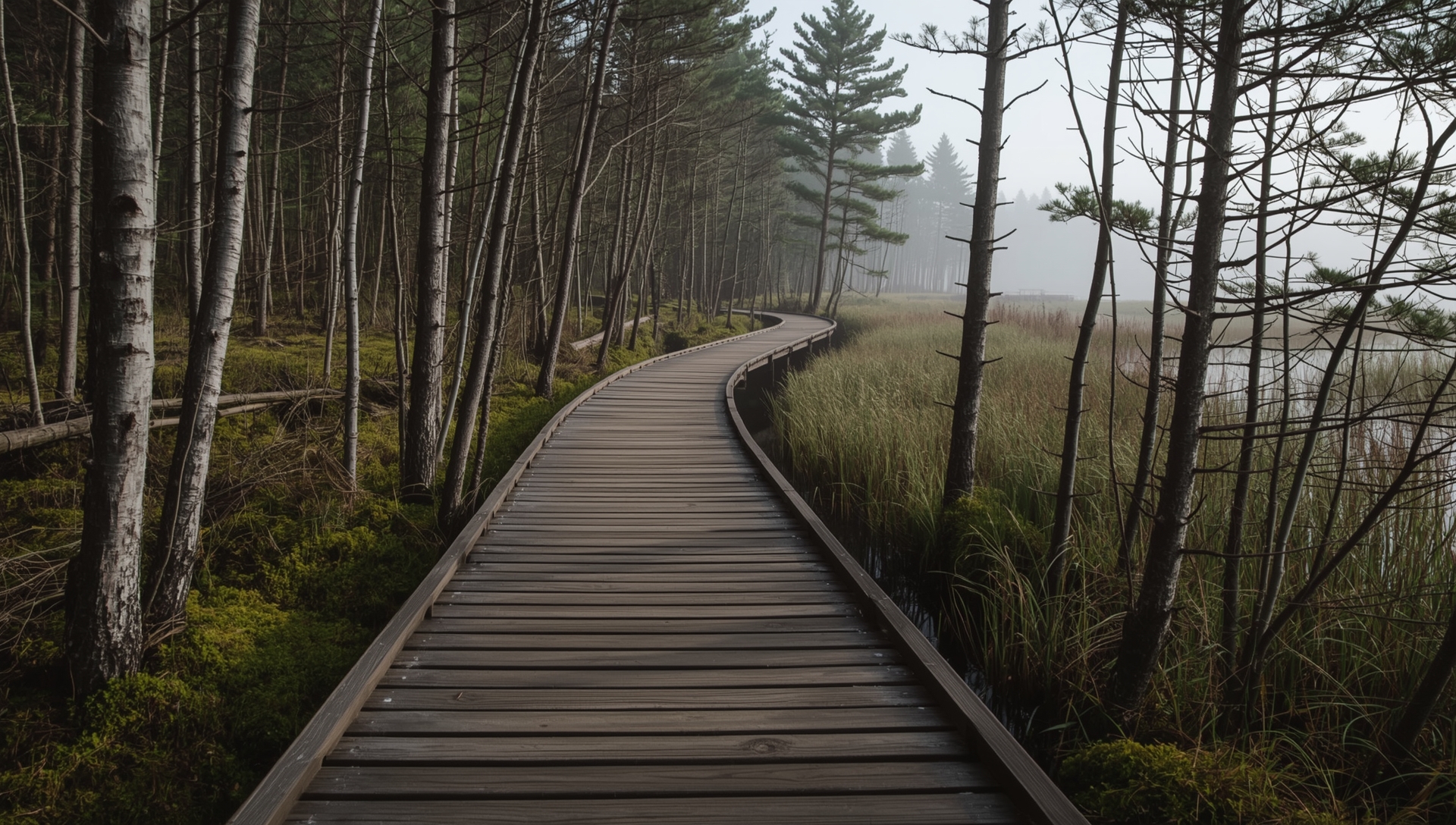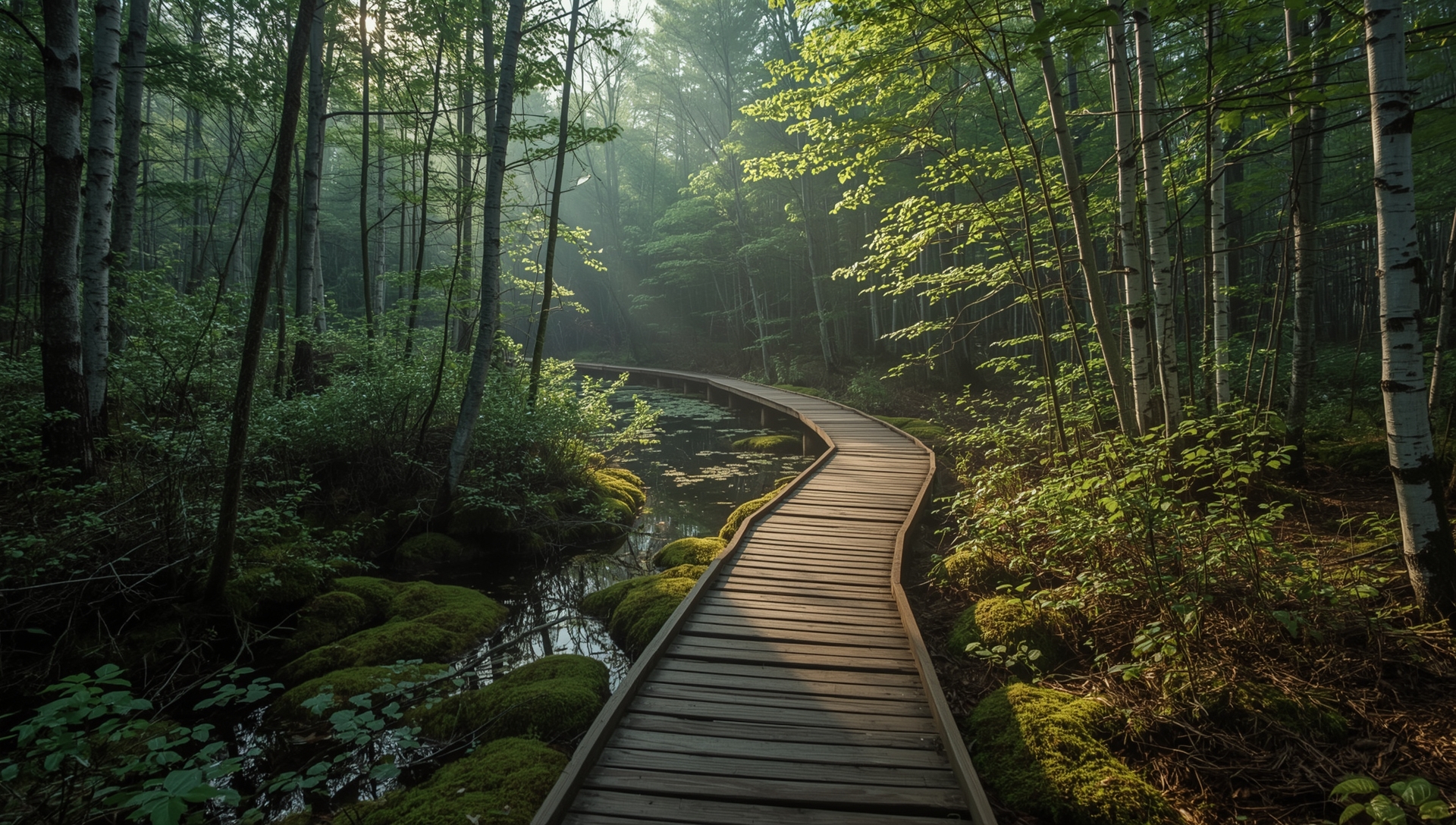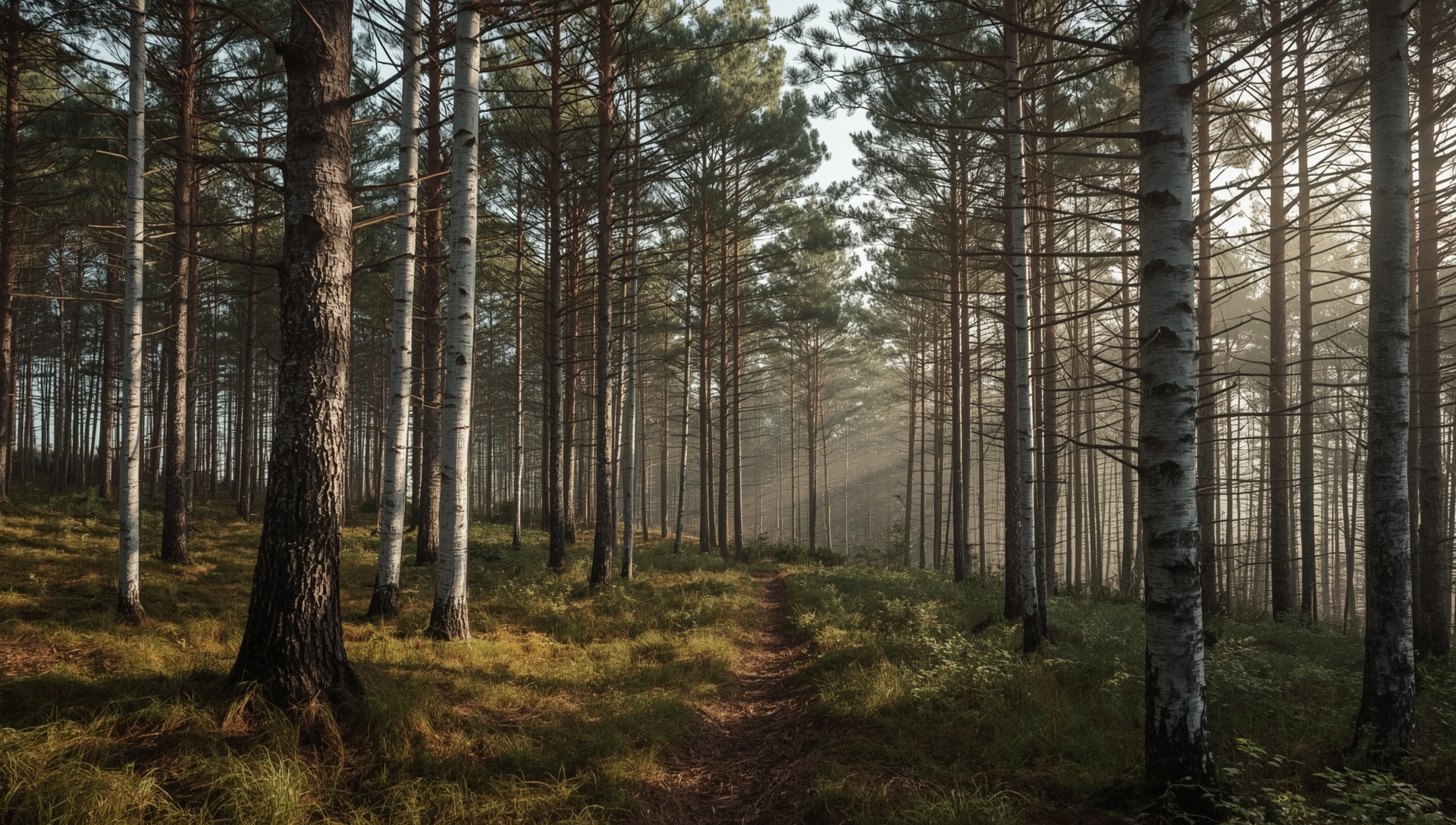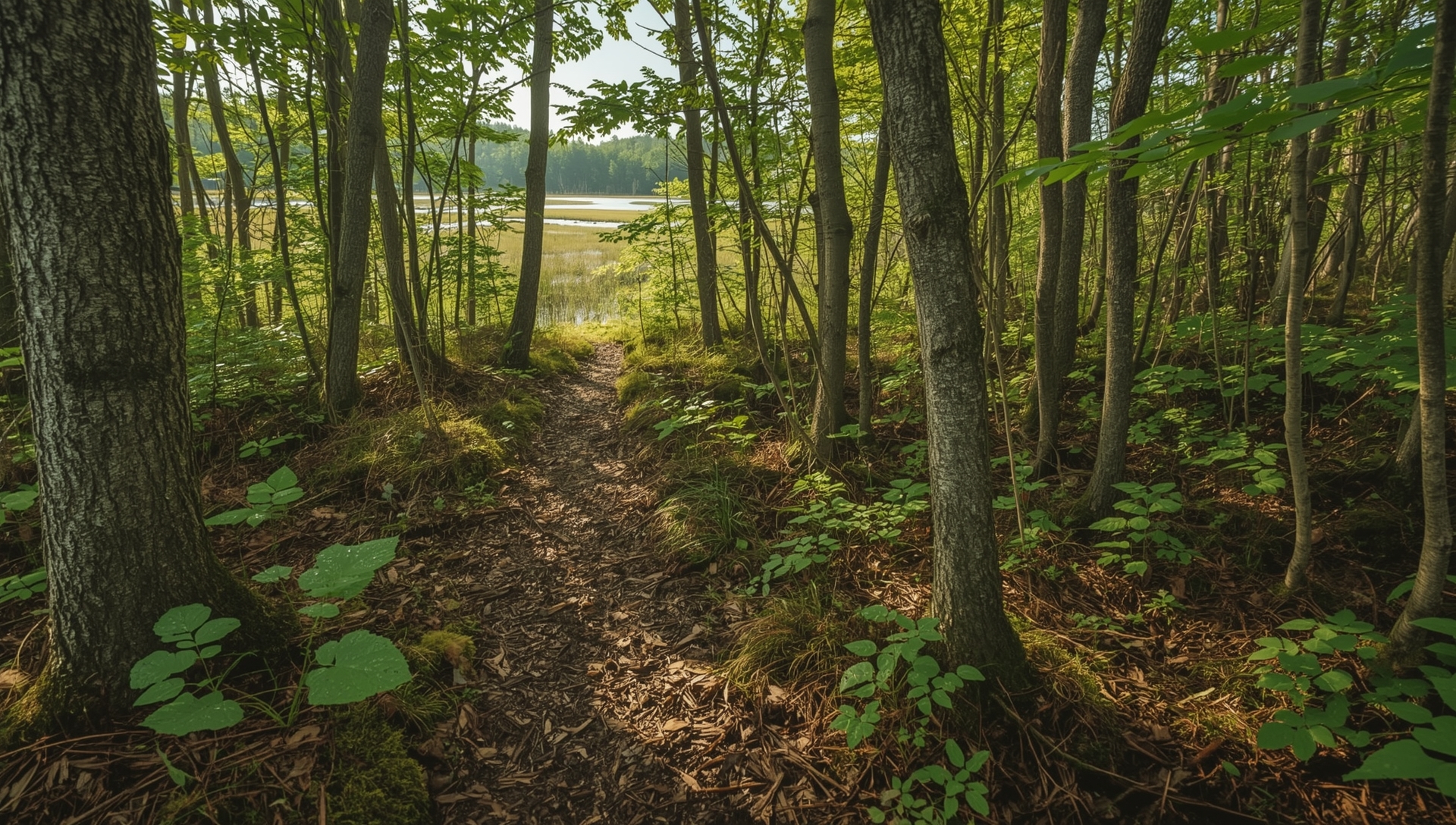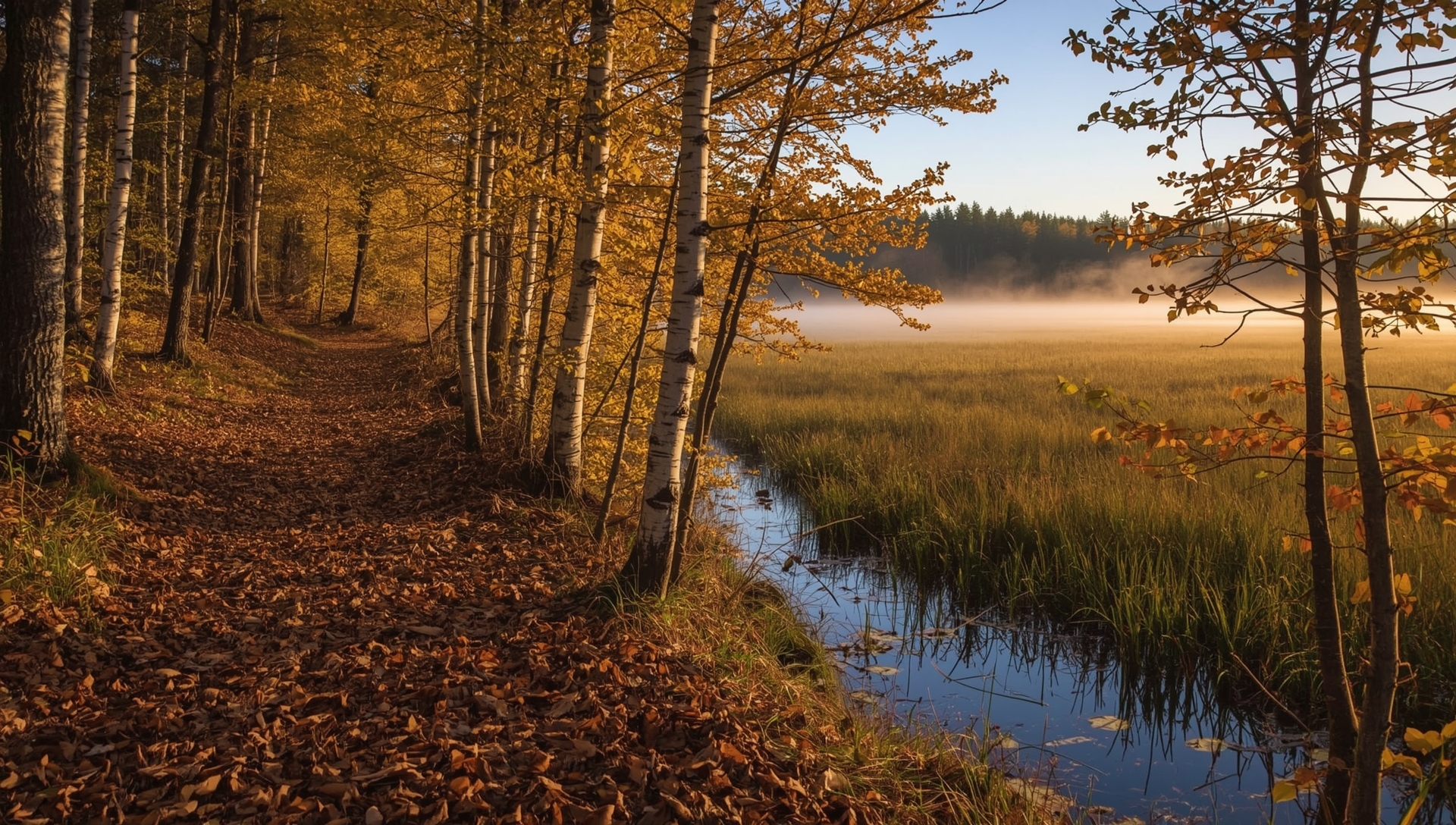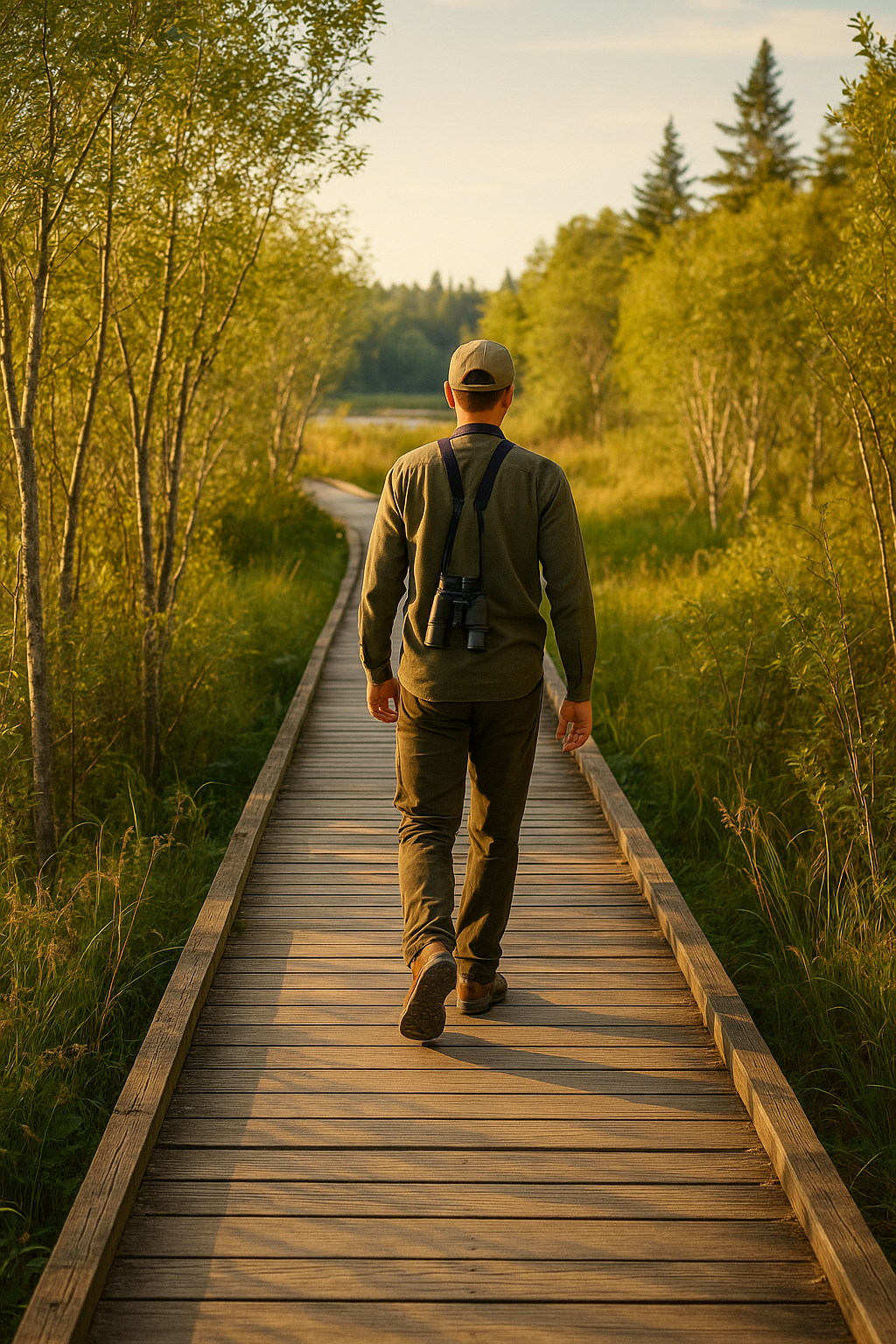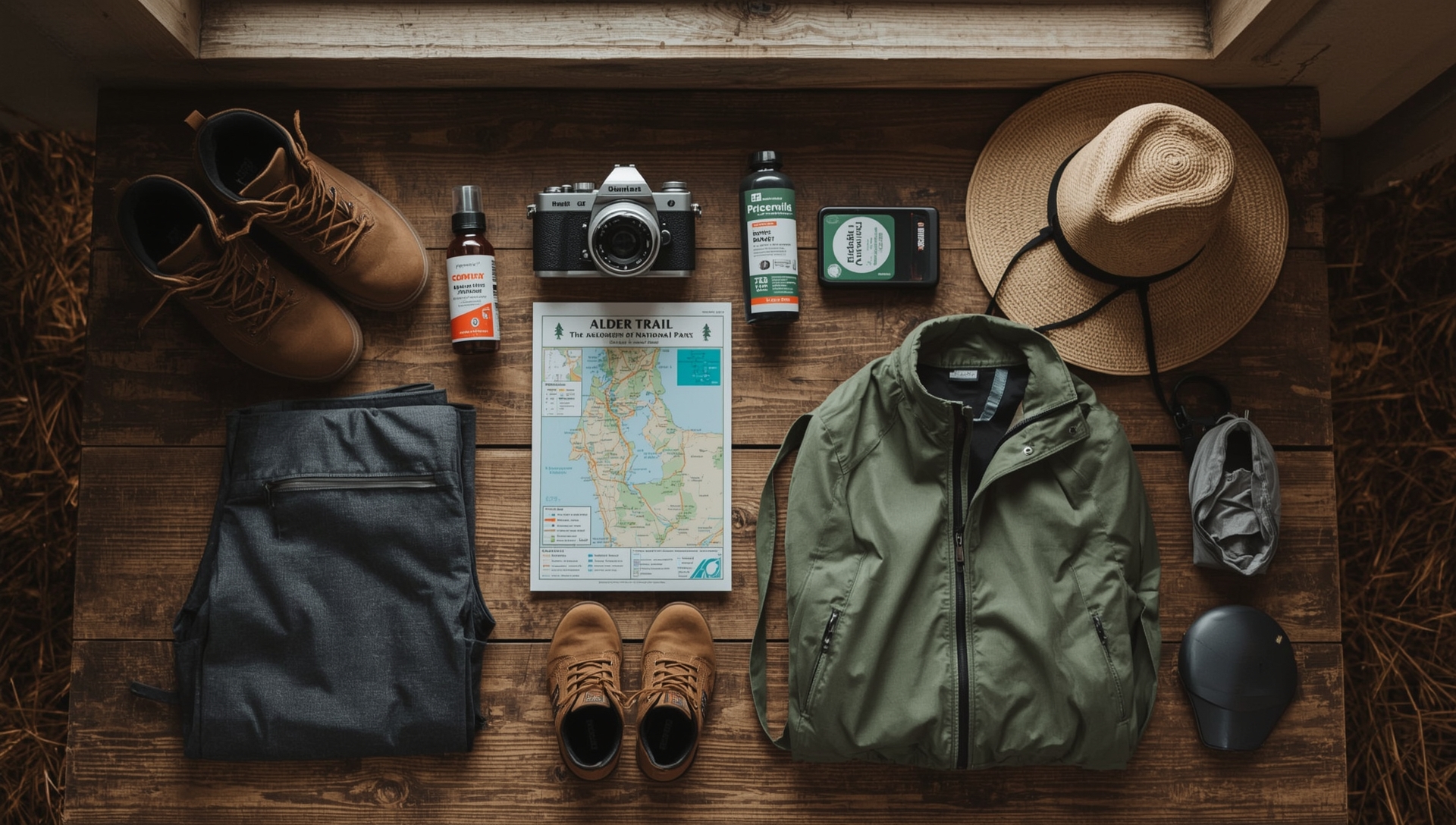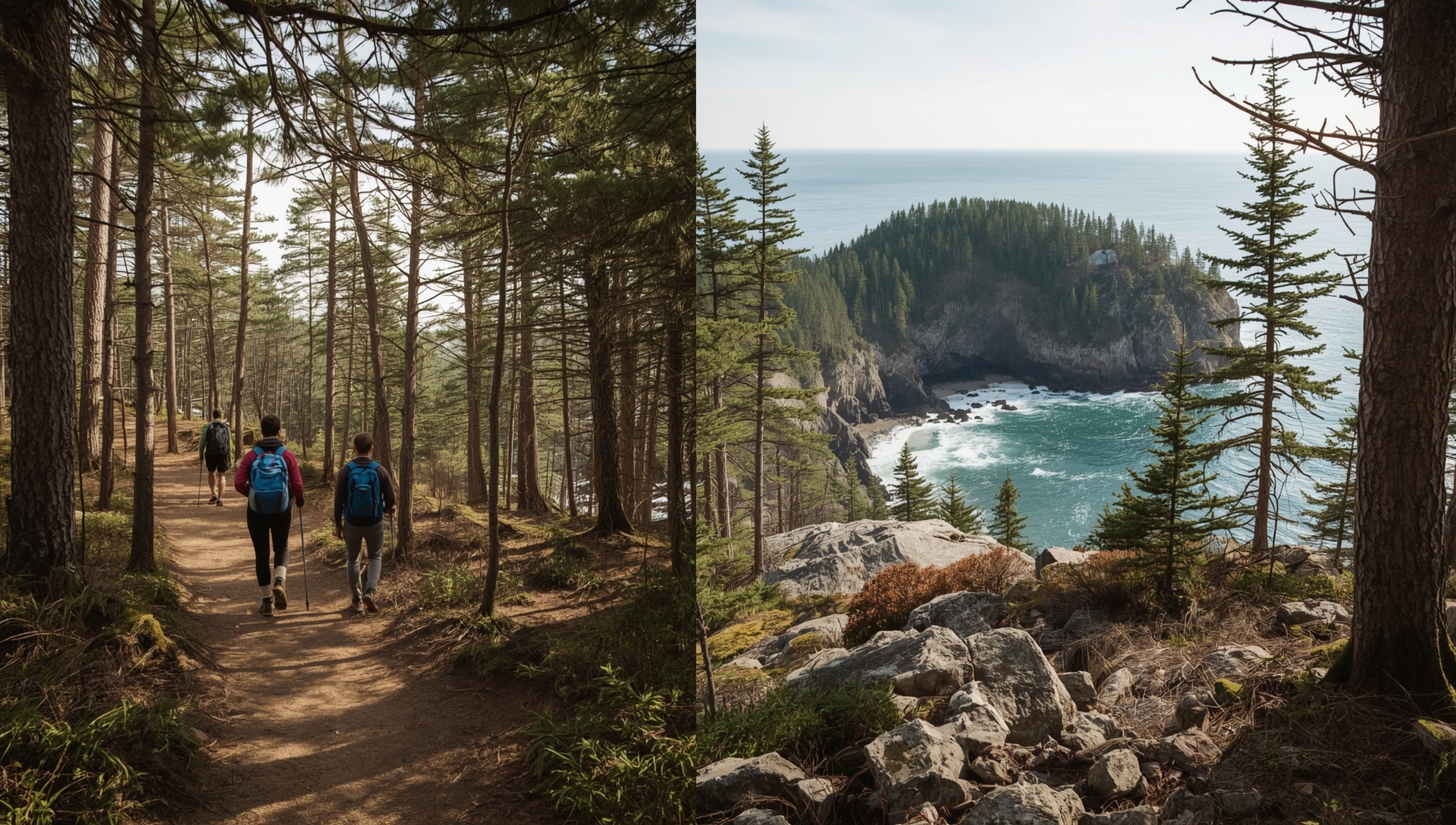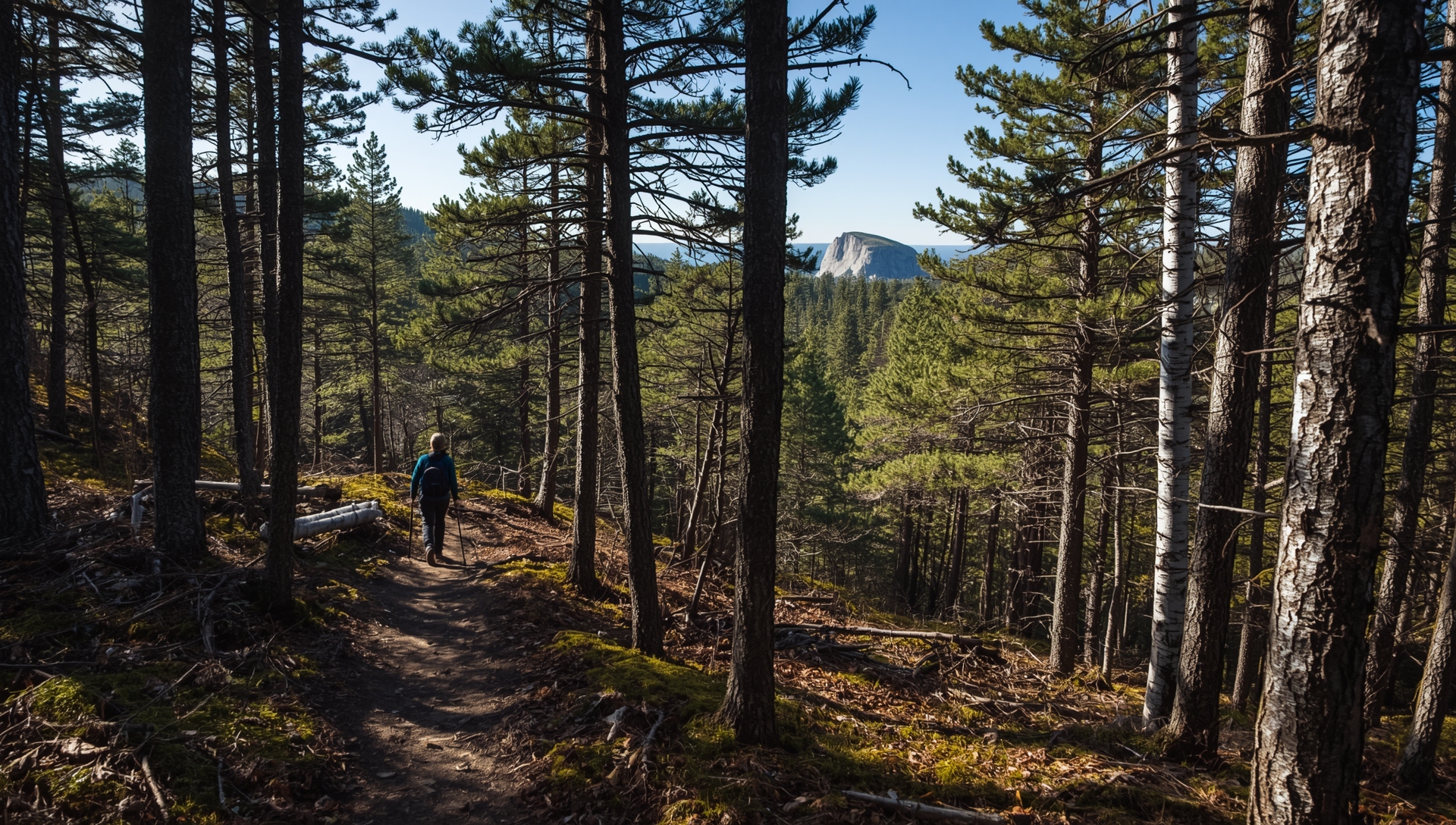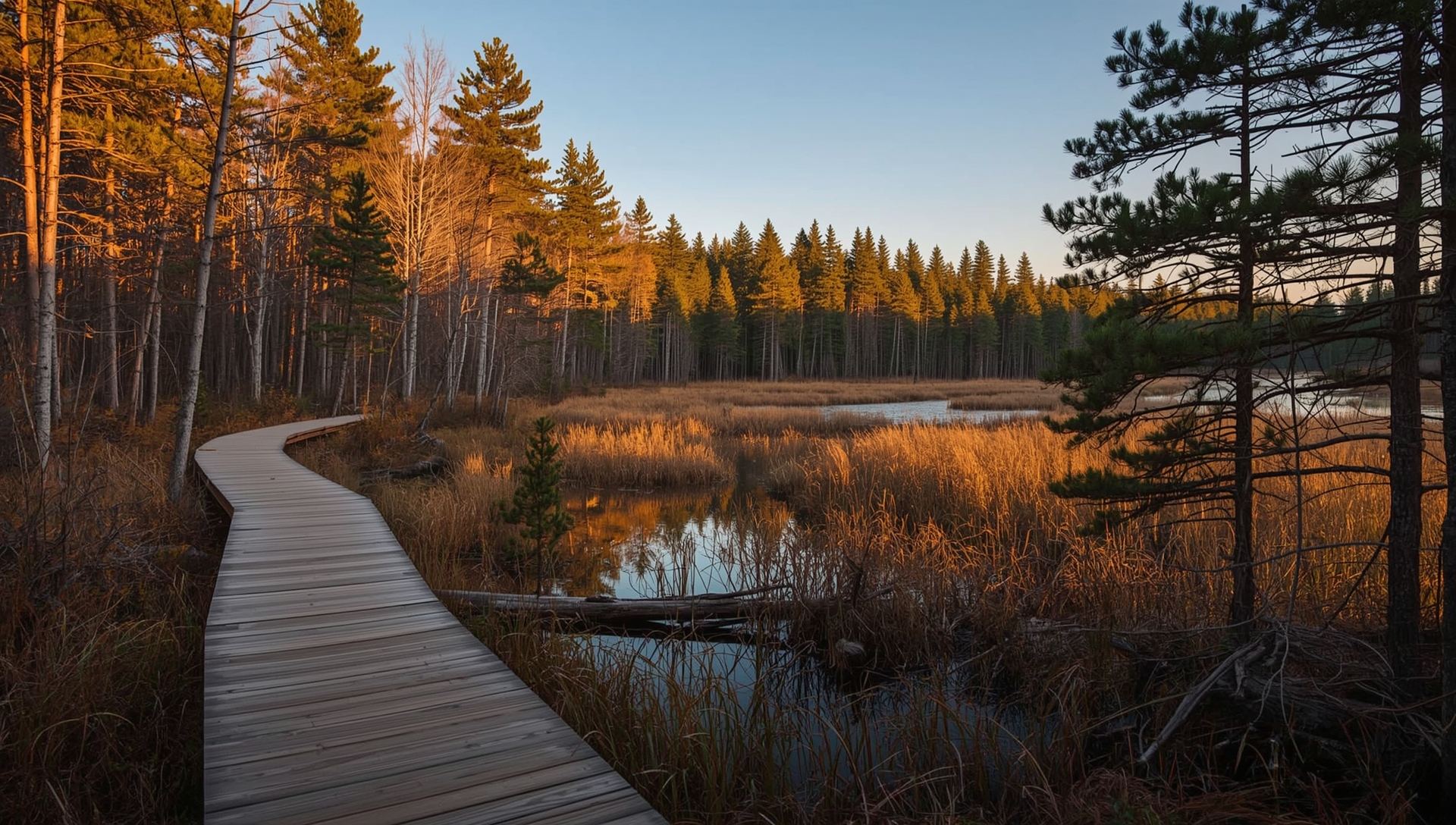Home › Acadia National Park › Trails in Acadia National Park › Alder Trail Acadia
Alder Trail in Acadia National Park
A Quiet Walk Through the Heart of Schoodic Peninsula
Tucked away on the peaceful Schoodic Peninsula, the Alder Trail in Acadia National Park offers a completely different rhythm from the park’s busier destinations. Where Cadillac Mountain draws sunrise seekers and Sand Beach fills with summer crowds, Alder Trail invites you to slow down — to trade sweeping ocean vistas for a more personal encounter with the landscape. Here, Acadia reveals its gentler moods: the hush of wind through alders, the soft crunch of gravel underfoot, and the glint of light on shallow pools that reflect the changing sky.
Stretching roughly a mile through low-lying wetlands and mixed forest, Alder Trail showcases the quiet ecosystems that thrive away from Acadia’s granite peaks. Boardwalks wind through stands of alder and birch, while glimpses of moss-covered logs and darting birds draw your attention closer to the forest floor. It’s the kind of walk where you might pause just to listen — to frogs calling in spring, to leaves trembling in a sea breeze, or to the steady rhythm of your own footsteps.
Because of its flat terrain and short distance, Alder Trail suits nearly everyone: families, casual walkers, birdwatchers, and photographers alike. It’s especially beautiful in the softer light of early morning or late afternoon, when the wetland colors deepen and reflections shimmer across the water. Whether explored as a standalone outing or linked with nearby routes like Anvil Trail or Schoodic Head, Alder Trail captures the essence of Schoodic — peaceful, understated, and profoundly connected to the quiet side of Acadia National Park.
• Located on the Schoodic Peninsula, the quieter mainland section of Acadia National Park.
• A gentle one-mile (1.6 km) walk through alder thickets, wetlands, and mixed forest.
• Ideal for families, birdwatchers, and photographers seeking calm and natural beauty.
• Features boardwalks, mossy forest paths, and reflections on still wetland pools.
• Connects easily with the Anvil Trail and Schoodic Head Trail for longer hikes.
• Highlights Acadia’s quiet inland ecosystems and softer side away from coastal cliffs.
• Accessible in all seasons — from spring wildflowers to autumn color and winter frost.
• Best enjoyed in early morning or late afternoon for soft light and solitude.
• A hidden gem that captures the peaceful rhythm of the Schoodic Peninsula.
About Alder Trail
The Alder Trail stretches for roughly one mile (1.6 km) one way, with almost no elevation gain, making it one of the most approachable and relaxing walks on the Schoodic side of Acadia National Park. It’s a trail that invites curiosity and calm rather than challenge — a place where you can slow your stride, breathe in the cool forest air, and rediscover Acadia’s quieter, more contemplative side. This short path may not lead to sweeping summit views, but it offers a different kind of reward: immersion in nature’s stillness, subtle movement, and sound.
From the moment you step onto the trail, the world feels softer. The Alder Trail in Acadia National Park begins among low thickets of alder, birch, and spruce, their silvery trunks catching the early light. The air smells faintly of salt and pine needles, carried inland from the nearby Atlantic. Beneath your feet, the path alternates between firm earth and smooth wooden boardwalks that lift you over small wetland pools. Sunlight filters through the trees, scattering golden reflections across the moss-covered ground. Birdsong fills the air — warblers, thrushes, and chickadees — creating a soundtrack that rises and falls with the breeze.
In places, the forest opens to reveal tranquil wetlands. The water lies so still that it mirrors the surrounding trees, their shapes gently rippling whenever a frog leaps from the bank or a breeze brushes the surface. Dragonflies hover in flashes of blue and green, while wildflowers fringe the edges of the pools in delicate bursts of color. If you pause and listen, you might hear the faint rustle of a squirrel or the distant call of a loon echoing from further inland. Every sense feels heightened here, every moment part of a slower rhythm that defines Acadia’s Schoodic Peninsula.
The trail’s simplicity belies its richness. After about half a mile, you’ll begin to notice the subtle transitions in landscape — from soft, shaded woodland to open clearings where sunlight dances on the water. The Alder Trail is also part of a larger network of paths that weave through this lesser-traveled region of the park. Toward its western end, it connects with the Anvil Trail, a moderate climb leading up through spruce forest to stunning granite ledges overlooking Frenchman Bay. Adventurous hikers can continue onward to the Schoodic Head Trail, where the peninsula’s highest point offers sweeping views across the Atlantic and toward Mount Desert Island. Together, these routes form a perfect balance of tranquility and discovery, allowing you to move from the quiet intimacy of the forest floor to the wide, wind-brushed world above.
Even on its own, though, Alder Trail holds its own quiet magic. It’s a place where light, sound, and reflection converge — where the beauty of Acadia lies not in the grand or the dramatic, but in the simple and profound. Whether you walk it as a short retreat or as part of a longer day on Schoodic’s trails, it offers a glimpse of the park at its most peaceful: soft light, steady footsteps, and nature’s rhythm unfolding, one quiet moment at a time.
• A gentle one-mile (1.6 km) loop on the Schoodic Peninsula in Acadia National Park.
• Winds through alder thickets, birch stands, and wetland openings.
• Blends forest shade and open marsh scenery with subtle seasonal change.
• Connects seamlessly with Anvil Trail and Schoodic Head Trail for variety.
• Perfect for slow-paced walks, quiet photography, and birdwatching.
Reaching the Heart of the Trail
The start of the Alder Trail welcomes you with a gentle transition into shaded woodland, where birch, spruce, and thick stands of alder grow closely together. Their pale, silvery bark gleams against the deep greens of the forest, catching stray beams of light that pierce the canopy. This interplay of texture and tone gives the trail its name — and much of its character. The air feels cool and alive, scented with pine and moss, and the sound of your own footsteps seems softened by the thick layer of needles and leaves beneath. As you follow the path deeper into the forest, the canopy draws closer, filtering sunlight into a shifting mosaic of shadow and gold.
In these early stretches, the Alder Trail in Acadia National Park feels intimate and enclosed — a woodland corridor where every curve of the path reveals something new. Ferns feather the forest floor, and the occasional shaft of light illuminates patches of wildflowers or clusters of mushrooms growing in the shade. Small birds flit between the branches overhead, their calls echoing softly through the stillness. It’s a calm, sensory beginning — the kind of quiet that settles both mind and body before the trail begins to open.
Before long, the terrain changes subtly. The forest thins, the ground levels out, and the scent of damp earth grows stronger. Ahead, the trail opens into low-lying marshland where wooden boardwalks stretch across the wetlands. These raised pathways let visitors pass gently through Acadia’s fragile ecosystems without disturbing them. Looking down, you might catch glimpses of rippling water reflecting the sky, lily pads drifting lazily near the reeds, or bright dragonflies weaving quick, glimmering lines through the sunlight.
Here, walking is less about covering distance and more about presence. The world seems to slow as you move, your pace syncing with the quiet pulse of the wetland. The silence is rarely complete — broken now and then by birdsong, the hum of insects, or the faint splash of something unseen. On misty mornings, the scene feels dreamlike: spiderwebs strung with dew, alder branches dripping softly, and the faint scent of rain lingering in the air.
Eventually, this stretch of calm connects with Acadia’s wider Schoodic network. For those who wish to go farther, the Alder Trail links naturally to the Anvil Trail and onward toward the Schoodic Head Trail, offering a perfect transition from still marsh to rocky forest slope. Together, these paths create a beautiful contrast — a journey from reflection to elevation, from quiet water to sweeping views.
It’s a reminder that even the simplest walk in Acadia can feel timeless, each step leading deeper into the park’s quiet heart.
• Walk through birch, spruce, and alder groves lit by morning light.
• Breathe the cool forest air before the wetlands unfold.
• A peaceful stretch of the Alder Trail in Acadia National Park.
• Mist, moss, and birdsongs echo through shaded paths.
• A glimpse of the Schoodic Peninsula’s quiet interior.
Flora, Fauna, and Atmosphere
The Alder Trail is a quiet sanctuary for those who enjoy observing nature up close. Every season reshapes its character, ensuring that no two walks along this tranquil path are ever quite the same. In spring, the forest floor wakes from its long frostbound rest, bursting with soft color and delicate scent. Wildflowers begin to paint the understory — blue flag irises brighten the wetter hollows, while starflowers and bunchberry cluster along the edges of the path. Trillium and violets add their fleeting hues, and new alder leaves shimmer in the light, their pale green standing out against the dark needles of spruce and pine. The air feels newly alive, filled with the scent of thawed earth and the gentle hum of early bees returning to the wetlands.
By early summer, the Alder Trail in Acadia National Park becomes a living soundscape. Dragonflies skim the still pools in quick, glittering arcs of blue, gold, and emerald. Frogs call from the marshy edges, their overlapping voices echoing softly across the water. The rustle of reeds, the splash of a startled fish, and the distant drumming of a woodpecker blend into a steady rhythm that defines the heart of the Schoodic Peninsula in its greenest season. The forest canopy deepens, offering shade and cool relief from the coastal sun, while patches of wild strawberry and creeping buttercup dot the ground with subtle color. Pause for a moment, and you might spot a garter snake slipping across a sun-warmed stone or the shadow of a heron gliding low over the ponds.
Autumn brings transformation. The alders and birches along the trail ignite into gold, amber, and russet, their reflections shimmering in the calm wetland pools. The moss underfoot glows with emerald light, and the low sun slants through the forest like liquid bronze. Each breeze releases a slow fall of leaves that spin lazily through the air. It’s a season made for stillness — the scent of wood smoke drifting faintly on the air, the crunch of dry leaves beneath your boots, and the echo of distant crows cutting through the quiet. Even as the days shorten, Alder Trail feels alive in its calm — a place where change unfolds gently, never abruptly.
For birdwatchers, Alder Trail offers year-round fascination. Warblers flit among the upper branches, chickadees chatter energetically in small flocks, and thrushes call from deep in the woods. In the quieter moments, you might hear the slow, powerful rhythm of a pileated woodpecker or glimpse a bald eagle circling above the wetlands. Early mornings and late afternoons are the best times to walk here — when light, sound, and stillness meet perfectly, and the Alder Trail reveals Acadia’s quieter, more intricate beauty.
• Wetlands and forest merge to form rich Acadia habitats.
• In spring, wildflowers and dragonflies brighten the marsh.
• Summer hums with frogs, birds, and forest life.
• Autumn brings golden leaves and soft sunlight through the trees.
• Ideal for birdwatching and quiet nature walks on the Schoodic Peninsula.
Photography and Seasonal Notes
The Alder Trail is a photographer’s trail in every sense — not because of sweeping vistas or dramatic summits, but because of its quiet, layered details. This is where the camera slows down, where reflections ripple softly across wetlands and sunlight filters gently through alder and birch. Every few steps reveal a new frame: a warbler caught mid-song, dew beading on moss, or the golden shimmer of reeds at sunset. The beauty of this trail lies not in grandeur, but in intimacy — scenes that reward patience, attention, and an unhurried pace. Each season reshapes the landscape, ensuring that no two visits or photo sessions ever feel the same.
- Alder Trail in the Fall: Color and Contrast
Autumn in Acadia National Park turns the Alder Trail into a corridor of fire and gold. The alders ignite in warm amber tones, glowing beside the dark evergreens. Still pools reflect this autumn blaze, while low sunlight creates soft contrasts that shift with every hour. For many visitors, this season defines the best time to visit Acadia, when the weather is crisp, the air clear, and the landscape painted in fleeting brilliance. Each bend of the trail becomes a new composition — tranquil, reflective, and deeply atmospheric.
- Alder Trail in Summer: Life in Motion
By summer, the Alder Trail hums with energy. Dragonflies hover over glassy pools, frogs call from hidden reeds, and the forest canopy filters dappled light in endless variations. The long days make it ideal for capturing detail — macro shots of insects, textures of bark and moss, or reflections under warm, golden-hour light. Summer on the Schoodic Peninsula offers an intimate counterpoint to the crowded trails of Mount Desert Island, especially for photographers seeking peace, wildlife, and gentle color.
- Acadia Trail in Spring: Renewal and Reflection
In spring, the Alder Trail in Acadia National Park awakens with color and light. Fresh greenery unfurls across the forest floor, while wildflowers such as blue flag iris, starflower, and bunchberry line the path. The wetlands mirror soft pastels under drifting mist — a gift for those who rise early. Morning walks offer the best light for photography, when the park feels hushed and alive with birdsong. For travelers wondering about the best time to visit Acadia National Park, spring provides solitude and a palette of renewal rarely found in busier months.
- Alder Trail in Winter: Quiet and Clarity
Even in winter, the Alder Trail holds its charm. The alders stand bare, their silver bark luminous against snow. Frost coats the grasses, and the wetlands freeze into glassy stillness. It’s a season for minimalism — where shadows, shapes, and textures replace color. For photographers, this is Acadia in winter at its most honest and serene: clean light, open air, and a silence that amplifies every detail. Under clear skies, the low sun bathes the forest in a soft, crystalline glow, turning the Schoodic woodlands into a world of quiet brilliance.
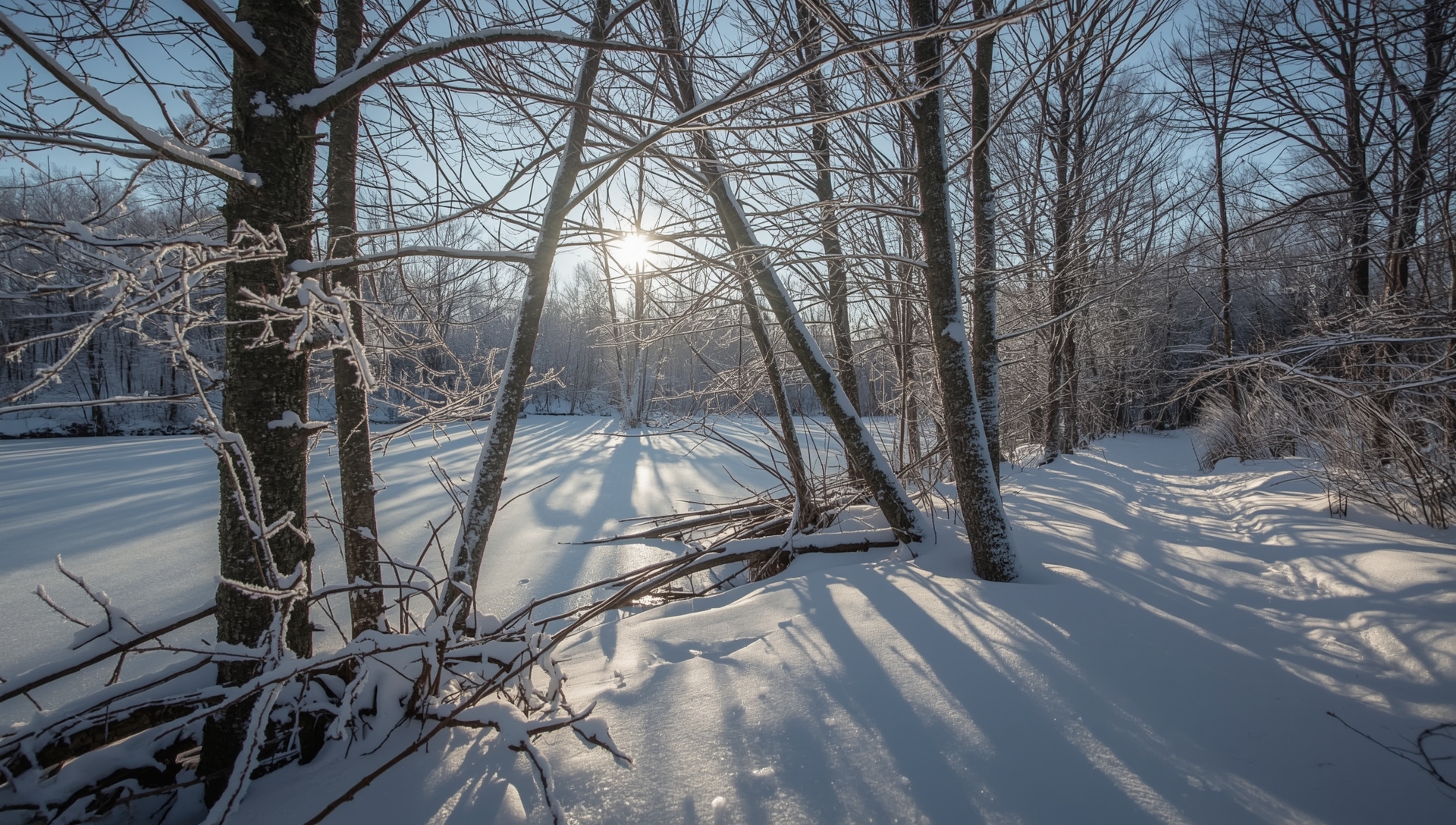 Soft morning light glows across snow and frost along the Alder Trail on Acadia’s Schoodic Peninsula.
Soft morning light glows across snow and frost along the Alder Trail on Acadia’s Schoodic Peninsula.• A favorite for nature photographers exploring Acadia National Park’s quieter trails.
• Offers reflections, soft light, and intimate forest details ideal for close-up shots.
• Each season brings new color — especially autumn’s gold and amber hues.
• Recognized as one of the best places for photography on the Schoodic Peninsula.
• A peaceful contrast to the busier viewpoints near Mount Desert Island.
Tips for Hiking Alder Trail
Though the Alder Trail is among the gentlest walks in Acadia National Park, a little preparation goes a long way toward making it memorable. Its mix of shaded forest, alder thickets, and damp wetlands means conditions can shift quickly with the seasons. One day the path might be firm and dry; another, it may glisten with dew or soft patches of moss. Knowing what to bring and how to approach the trail allows you to slow down, stay comfortable, and fully appreciate the quiet rhythm of the Schoodic Peninsula. Below are some practical tips — what to take before you set out, and what to do once you arrive — to help you enjoy this peaceful corner of Acadia at its best.
What to Take on the Alder Trail
The Alder Trail might be one of Acadia’s easiest walks, but the right gear turns a simple stroll into a smooth and comfortable nature experience. Because the trail crosses wetlands, alder thickets, and shaded forest, its conditions shift with each season. Preparation helps you focus on the beauty around you, not the footing under your boots.
Start with footwear. The path is mostly level, but expect patches of soft earth, particularly after rainfall. Waterproof hiking shoes or lightweight boots are ideal—something with a grippy tread to handle slick spots on the boardwalk or muddy edges near the marshes. Even in summer, dew and standing water can linger along the trail, so sandals or mesh sneakers often end up damp within minutes.
Clothing should change with the seasons. In spring and autumn, layering is key: a breathable base layer, a fleece or light jacket, and something wind-resistant if the air carries ocean chill. In summer, go for light long sleeves and pants that protect from both sun and insects; mosquitoes love the still air around the wetlands. In winter, the short distance of the trail doesn’t mean you can underdress—gloves, a hat, and a waterproof shell will keep you comfortable if you pause for photos or birdwatching.
Bring small essentials. A bottle of water fits easily into a daypack, as does insect repellent, sunscreen, and a basic first-aid kit. Binoculars are almost a must-bring item; the Schoodic Peninsula is known for its birdlife, and this trail is one of the best quiet places to spot warblers, woodpeckers, and thrushes. Photographers will appreciate a camera with a zoom lens or even a compact tripod for low-light forest shots.
Finally, don’t forget timing tools—a charged phone, a watch, or a map if you plan to extend your walk to Anvil Trail or Schoodic Head Trail. Though Alder is easy to follow, these connecting routes add variety and elevation, giving you both the peaceful lowlands and Acadia’s sweeping views in one outing. Preparation means freedom: pack lightly, plan smartly, and you’ll enjoy every sound and scent the trail has to offer.
What to Do When You Get There
Stepping onto the Alder Trail feels like entering a softer world within Acadia—quiet, shaded, and close to the earth. Once you’ve arrived, slow down. The path isn’t about speed or distance but discovery. Each step reveals subtle textures: alder bark gleaming silver in filtered light, the glint of water between reeds, the flutter of a dragonfly hovering over a mossy pool.
Start early or late in the day for the best experience. Mornings bring birdsong—chickadees, warblers, and thrushes fill the air with sound. The light slants through the canopy, creating perfect photography conditions with long shadows and mist over the wetlands. Late afternoon offers similar calm, with golden hues softening the forest. Midday can be pleasant too, but insect activity is higher, so linger under the breezy patches if you pause.
As you walk, take advantage of the wooden boardwalks that protect the wetland floor. They keep your feet dry and prevent erosion, helping preserve fragile ecosystems. Stop midway where the trail opens to the marsh; you’ll often see mirrored reflections of the sky and treetops. If you’re quiet, you may catch the splash of a frog or the glide of a heron crossing the water.
Those wanting a longer adventure can extend their outing. The Alder Trail connects naturally with Anvil Trail, which climbs through pine forest toward rocky ridges, and from there with Schoodic Head Trail, rewarding hikers with panoramic views of Frenchman Bay. Together, they form one of the most balanced hiking circuits on the Schoodic Peninsula—wetland, woodland, and summit all within a few hours.
Above all, follow Leave No Trace principles. Stay on marked paths, avoid disturbing plants or nesting birds, and carry all rubbish out. Even short trails like Alder are sensitive ecosystems; every footprint matters. Treat it as a living museum—observe, listen, and respect its rhythm. By doing so, you’ll leave the same quiet beauty intact for the next hiker who seeks peace among the alders.
• Bring sturdy waterproof shoes for damp sections and marsh crossings.
• Pack layers, bug spray, and water — conditions change quickly by season.
• Early mornings and evenings offer best light and bird activity.
• Extend your walk via the Anvil Trail or Schoodic Head Trail for added views.
• Follow Leave No Trace principles to protect Acadia’s fragile wetlands.
Nearby Trails and Connections
The Alder Trail is best enjoyed as part of a wider day exploring the Schoodic Peninsula, where a network of short but distinct trails reveals the area’s remarkable diversity. Within a few miles, you can wander from tranquil wetlands to granite ridges and rugged coast — all without crowds. Linking Alder Trail with its neighboring routes transforms a quiet walk into a full sensory experience of Acadia’s less-traveled side.
Each of these connecting paths offers its own rhythm. Some move slowly through shaded forest; others rise abruptly to panoramic lookouts or follow the sea’s edge. Combined, they tell the complete story of the Schoodic landscape — a balance between softness and strength, reflection and exhilaration.
Just a short drive or walk from the Alder Trailhead, the Anvil Trail rises through spruce forest to a broad granite outcrop resembling a blacksmith’s anvil. The climb, though brief, is lively — a series of rocky steps that open onto sweeping views of Frenchman Bay, Little Moose Island, and the blue line of Mount Desert Island beyond. From the top, the wetlands and thickets of Alder Trail appear as a quiet green mosaic below. It’s an ideal pairing: Alder’s calm intimacy followed by Anvil’s expansive drama.
Continuing upward from the Anvil Trail junction, the Schoodic Head Trail leads to one of the peninsula’s signature viewpoints. The summit of Schoodic Head offers a full panorama — forest, ocean, and the scattered islands that dot the bay. On clear days, you can see all the way to Cadillac Mountain across the water. The route feels wilder and more remote than its short length suggests, with the sound of surf far below and wind whispering through spruce and fir. Many hikers link Alder → Anvil → Schoodic Head as a half-day circuit that flows naturally from marsh to mountaintop.
If you crave the sound of waves, end your Schoodic day on the Lower Harbor Trail. Here, the forest gives way to rocky shoreline, tidal pools, and the scent of salt air. It’s a striking contrast after Alder’s hush — gulls cry overhead, the tide laps against granite slabs, and sunlight flashes across the sea. Short connecting paths allow you to loop back inland toward the Alder wetlands, completing a circuit that moves from water to woods and back again.
Together, these trails showcase the Schoodic Peninsula’s layered beauty: the subtle textures of alder marshes, the resilience of spruce-clad hills, and the timeless rhythm of waves meeting rock. Walking them in sequence reveals a side of Acadia that feels deeply personal — wilder, quieter, and endlessly rewarding.
Wrapping Up
The Alder Trail might not command the sweeping views or rugged climbs that define Acadia’s iconic summits, but that’s exactly what gives it its quiet strength. It offers something rarer — a pause. Here, along the Schoodic Peninsula, you trade dramatic cliffs for still reflection, and in return, you gain intimacy with the subtler side of nature. The trail’s rhythm is slow and steady, marked by the whisper of wind through alder branches and the soft murmur of frogs in hidden pools. Every step draws you closer to the small details — the gleam of dew on moss, the shifting shadows across birch trunks, the quiet echo of your own footsteps softened by forest earth.
As the day fades, the Alder Trail takes on a golden calm. Light filters low through the trees, brushing the wetland edges in warmth. The mirrored surface of the pools catches the glow, turning the landscape into a canvas of reflection and movement. For photographers, birdwatchers, and wanderers alike, it’s an ideal place to linger, to let time slow down with the sun.
When paired with neighboring routes like Anvil Trail, Schoodic Head, or Lower Harbor, Alder Trail reveals how much variety exists within a single peninsula — from shaded forest and wetland life to granite summits and salt air. It’s not a trail that demands effort, only awareness. In the end, Alder Trail reminds you that the quietest paths often leave the deepest impressions — the kind that stay with you long after the forest falls silent.
• Experience Acadia National Park’s quieter side on the Schoodic Peninsula.
• A reflective walk through wetlands, alder groves, and soft forest light.
• Ideal for photographers and birdwatchers seeking peace and stillness.
• Pairs perfectly with nearby hikes like Anvil Trail and Schoodic Head.
• Best visited in late afternoon or autumn for golden light and calm air.
The Alder Trail offers a quieter kind of beauty, where wetlands, mossy paths, and alder thickets create a space for reflection. It’s a gentle walk that proves Acadia’s smaller moments can be just as rewarding as its grandest summits.
Back to Schoodic
- NPS: Schoodic Peninsula Trails – official trail network, notes on Schoodic Head/Alder connections.
- Schoodic Institute (About) – Acadia’s primary science & education partner on the Schoodic Peninsula.
- Maine Trail Finder: Schoodic Hiking Trails – user-friendly overview with maps & tips.
Want insider trail tips and fresh park updates? Join our free newsletter and get planning advice, seasonal alerts, and hidden gems in your inbox.
Sign Up
